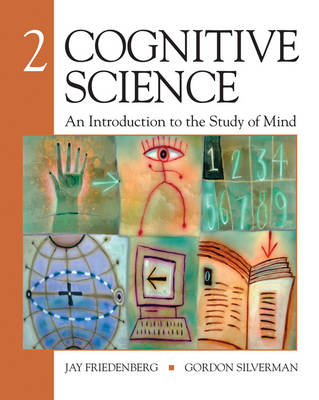
Cognitive Science
SAGE Publications Inc (Verlag)
978-1-4129-7761-6 (ISBN)
- Titel erscheint in neuer Auflage
- Artikel merken
In this Second Edition of their landmark text, Authors Jay Friedenberg and Gordon Silverman survey significant theoretical models of the human mind from an interdisciplinary perspective. Unlike other texts for this course which focus solely on classic experiments to illustrate major phenomena, Cognitive Science introduces students to the theoretical models and ideas underlying such empirical work. While experiments are discussed, they are used primarily to illustrate the specific characteristics of a model. This edition includes two new chapters on emotional cognition and social cognition.
Jay Friedenberg is Professor of the Psychology Department at Manhattan College, where he directs the Cognitive Science Program. He is interested in both vision and the philosophy of mind. He teaches courses in physiological psychology, cognition and learning, sensation and perception, and artificial intelligence and robotics. He has published several articles on visual estimation of center of mass. His current research projects focus on the aesthetics of geometrical shapes. He has published books on artificial intelligence, dynamical systems theory, and psychology. He is a member of the International Association of Empirical Aesthetics, the Eastern Psychological Association, the Vision Science Society, the Psychonomic Society, and Phi Beta Kappa. He obtained his PhD in cognitive psychology in 1995 at the University of Virginia. Gordon Silverman is Professor Emeritus of Electrical and Computer Engineering at Manhattan College. His professional career spans more than 55 years of corporate, teaching, consulting, and research experience, during which he has developed a range of scientific instruments, particularly for use in physiological psychology research environments. He is the holder of eight patents, some related to behavior modification. The author of more than 20 journal articles and books, he has also served on the faculties of The Rockefeller University and Fairleigh Dickinson University. His current research interests include telemedicine, rehabilitation medicine, artificial intelligence, and biomedical instrumentation and modeling. He holds engineering degrees from Columbia University and received a PhD in system science from New York University Polytechnic School of Engineering in 1972.
1. Introduction: Exploring Inner Space
A Brave New World
What Is Cognitive Science?
Representation
Computation
The Interdisciplinary Perspective
Interdisciplinary Crossroads: The Philosophy and Psychology of Mental Representation
Summing Up: Review of Chapter 1
2. The Philosophical Approach: Enduring Questions
What Is Philosophy?
The Mind-Body Problem
Monism
Dualism
Functionalism
The Knowledge Acquisition Problem
The Mystery of Consciousness
Overall Evaluation of the Philosophical Approach
Interdisciplinary Crossroads: Philosophy, Neuroscience and Binocular Rivalry
Summing Up: Review of Chapter 2
3. The Psychological Approach: A Profusion of Theories
What Is Psychology?
Psychology and the Scientific Method
Mental Atoms, Mental Molecules, and a Periodic Table of the Mind: The Voluntarist Movement
Structuralism: What the Mind Is
Functionalism: What the Mind Does
The Whole Is Greater Than the Sum of Its Parts: Mental Physics and the Gestalt Movement
Mini-Minds: Mechanism and Psychoanalytic Psychology
Mind as a Black Box: The Behaviorist Approach
Overall Evaluation of the Psychological Approach
Interdisciplinary Crossroads: Gestalt Phenomenology, Experimental Psychology and Perceptual Grouping
Summing Up: A Review of Chapter 3
4. The Cognitive Approach I: Vision, Pattern Recognition and Attention
Some History First: The Rise of Cognitive Psychology
The Cognitive Approach: Mind as an Information Processor
Modularity of Mind
Theories of Vision and Pattern Recognition
Theories of Attention
Evaluating the Model-Building Approach
Interdisciplinary Crossroads: Computational Vision and Pattern Recognition
Summing Up: A Review of Chapter 4
5. The Cognitive Approach II: Memory, Imagery, and Problem Solving
Types of Memory
Memory Models
Visual Imagery
Problem Solving
Overall Evaluation of the Cognitive Approach
Interdisciplinary Crossroads: Artificial Intelligence, Problem Solving and the SOAR Model
Summing Up: A Review of Chapter 5
6. The Neuroscience Approach: Mind As Brain
The Neuroscience Perspective
Methodology in Neuroscience
Modern Brain Imaging Methods
Brain Stimulation Techniques
The Small Picture: Neuron Anatomy and Physiology
The Big Picture: Brain Anatomy
The Neuroscience of Visual Object Recognition
The Neuroscience of Attention
Disorders of Attention
The Neuroscience of Memory
Neural Substrates of Working Memory
Neural Substrates of Long-Term Memories
The Neuroscience of Executive Function and Problem Solving
Overall Evaluation of the Neuroscience Approach
Interdisciplinary Crossroads: Perceptual Binding and Neural Synchrony
Summing Up: A Review of Chapter 6
7. The Network Approach: Mind as a Web
The Network Perspective
Artificial Neural Networks
Semantic Networks: Meaning in the Web
Network Science
Overall Evaluation of the Network Approach
Interdisciplinary Crossroads: Emotions and Networks
Summing Up: A Review of Chapter 7
8. The Evolutionary Approach: Change Over Time
The Evolutionary View
A Little Background: Natural Selection and Genetics
Comparative Cognition
Evolutionary Psychology
Overall Evaluation of the Evolutionary Approach
Interdisciplinary Crossroads: Evolutionary Processes and Artificial Life
Summing Up: A Review of Chapter 8
9. The Linguistic Approach: Language and Cognitive Science
The Linguistic Approach: The Importance of Language
The Nature of Language
Language Use in Primates
Language Acquisition
Language Deprivation
Cognition and Linguistics: The Role of Grammar
Neuroscience and Linguistics: The Wernicke-Geschwind Model
Artificial Intelligence and Linguistics: Natural Language Processing
Overall Evaluation of the Linguistic Approach
Interdisciplinary Crossroads: Language, Philosophy and the Linguistic Relativity Hypothesis
Summing Up: A Review of Chapter 9
10. The Emotional Approach: Mind as Emotion
What is Emotion?
Basic Emotions
Theories of Emotion
Hot and Cold: Emotion-Cognition Interactions
Emotions and Neuroscience
Emotions, Evolution and Psychological Disorders
Emotions and Artificial Intelligence: Affective Computing
Overall Evaluation of the Emotional Approach
Interdisciplinary Crossroads: Emotion, Robotics and the Kisment Project
Summing Up: A Review of Chapter 10
11. The Social Approach: Mind as Society
Social Cognition
Evolution and Social Cognition
Attention and Social Cognition
Social Cognitive Neuroscience
Theory of Mind
Other Social Cognitive Disorders
Attitudes
Impressions
Attribution
Stereotypes
Prejudice
Overall Evaluation of the Social Approach
Interdisciplinary Crossroads: Game Theory and Prisoner’s Dilemma
Summing Up: A Review of Chapter 11
12. The Artificial Intelligence (AI) Approach I: The Mind As Machine
Cognitive Science from the AI Perspective
Historical Precursors
Universal Computation and Turing’s Contribution
The Turing Test
Evaluating the Work of Turing’s Universal Computing Machine
Predictive Architectures and Their Physical Challenges
Evaluating Machine Computational Limitations
Artificial General Intelligence (AGI)
Evolutionary Computing
Evaluation of Evolutionary Computing and Artificial General Intelligence
Agent-Based Architectures
Multiagent Systems
Overall Evaluation of the Computer as a Model of Brain Organization
Interdisciplinary Cross-Roads*fill in later
13. Artificial Intelligence II: Embodiments and Robotics
Introduction
The IA Paradigm
Why Biology is Important
Modeling Aspects of Biological Systems
Abstracting General Principles of IAs
Embodiment and situational aspects of intelligent behavior
Relationships between elements of the IA system (structure) and the environment
Applying the principles to the design of IAs
Cognitive Models of IAs
Deep Blue and the Chess Master
Can an IA “learn” to play a winning game without knowing anything about the game?
Expert Systems – a culminating “top-down” example
Why Not Build a Brain – the Blue Brain Project
Robotic Embodiments – Ultimate IAs
Defining a robotic embodiment
The IA Embodiment Paradigm Explored
Robotic Architectures
Hierarchical Architectures
Reactive Architectures
The Hybrid Deliberative/Reactive Paradigm
Biological and Social Influences on Robots
Swarming – what animals can teach us.
Robotic Simulation
Overall Evaluation of an IA Embodiment
Interdisciplinary Cross-Roads: Where Biology Meets Technology
Summing Up: A Review of Chapter 13
14. Conclusion: Where We Go From Here
The Benefits of Cognitive Science
Issues in Cognitive Science
The Dynamical Systems Approach
Dynamical Representation
Dynamical vs. Classical Cognitive Science
Evaluating the Dynamical Perspective
Integrating Cognitive Science
The Future
Interdisciplinary Crossroads: Multiple Approaches to Levels of Explanation in Cognitive Science
Summing Up: A Review of Chapter 14
| Verlagsort | Thousand Oaks |
|---|---|
| Sprache | englisch |
| Maße | 187 x 231 mm |
| Gewicht | 880 g |
| Themenwelt | Geisteswissenschaften ► Psychologie ► Allgemeine Psychologie |
| Geisteswissenschaften ► Psychologie ► Verhaltenstherapie | |
| ISBN-10 | 1-4129-7761-4 / 1412977614 |
| ISBN-13 | 978-1-4129-7761-6 / 9781412977616 |
| Zustand | Neuware |
| Haben Sie eine Frage zum Produkt? |
aus dem Bereich



